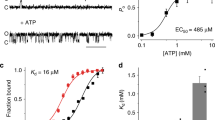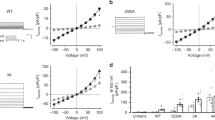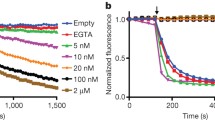Abstract
Proteins of the bestrophin family produce Ca2+-activated Cl− currents and regulate voltage-gated Ca2+ channels. Bestrophin 1 was first identified in the retinal pigment epithelium. Four human paralogs (hBest1–hBest4) exist, and for some bestrophins, dimeric and heterotetrameric structures have been proposed. Here, we demonstrate that hBest1–hBest4 induce Cl− conductances of different amplitudes when expressed in HEK293 cells and when activated through purinergic stimulation. hBest1 mutants that are known to cause autosomal dominant macular dystrophy (Best disease) did not produce a Cl− current. Bestrophins were colocalized and showed molecular and functional interaction in HEK293 cells, overexpressing hBest1 and hBest2 or hBest4. Interaction was confirmed in airway epithelial cells coexpressing endogenous bestrophins. A fraction of hBest2 and hBest4 was expressed in the membrane, while most of hBest1 was found in the endoplasmic reticulum. Nevertheless, hBest1 has a clear role for the adenosine triphosphate (ATP; or uridine triphosphate)-induced Cl− current in both HEK293 and Calu-3 cells. Since native epithelial tissues typically express several bestrophin paralogs, these proteins may exist as heterooligomeric structures.





Similar content being viewed by others
References
Al Jumaily M, Kozlenkov A, Mechaly I, Fichard A, Matha V, Scamps F, Valmier J, Carroll P (2007) Expression of three distinct families of calcium-activated chloride channel genes in the mouse dorsal root ganglion. Neurosci Bull 23:293–299
Barro Soria R, Schreiber R, Kunzelmann K (2008) Bestrophin 1 and 2 are components of the Ca2+ activated Cl− conductance in mouse airways. BBA 1783:1993–2000
Barro Soria R, Spitzner M, Schreiber R, Kunzelmann K (2006) Bestrophin 1 enables Ca2+ activated Cl− conductance in epithelia. J Biol Chem 281:17460–17467
Caputo A, Caci E, Ferrera L, Pedemonte N, Barsanti C, Sondo E, Pfeffer U, Ravazzolo R, Zegarra-Moran O, Galietta LJ (2008) TMEM16A, a membrane protein associated with calcium-dependent chloride channel activity. Science 322(5901):590–594
Chien LT, Zhang ZR, Hartzell HC (2006) Single Cl− channels activated by Ca2+ in Drosophila S2 cells are mediated by bestrophins. J Gen Physiol 128:247–259
Cunningham SA, Awayda MS, Bubien JK, Ismailov II, Arrate MP, Berdiev BK, Benos DJ, Fuller CM (1995) Cloning of an epithelial chloride channel from bovine trachea. J Biol Chem 270:31016–31026
Duta V, Szkotak AJ, Nahirney D, Duszyk M (2004) The role of bestrophin in airway epithelial ion transport. FEBS Lett 577:551–554
Eggermont J (2004) Calcium-activated chloride channels: (un)known, (un)loved? Proc Am Thorac Soc 1:22–27
Galietta LJ, Haggie PM, Verkman AS (2001) Green fluorescent protein-based halide indicators with improved chloride and iodide affinities. FEBS Lett 499:220–224
Hartzell HC (2008) Molecular physiology of bestrophins: multifunctional membrane proteins linked to best disease and other retinopathies. Physiol Rev 88:639–672
Hartzell HC, Putzier I, Arreola J (2005) Calcium-activated chloride channels. Annu Rev Physiol 67:719–758
Jentsch TJ, Stein V, Weinreich F, Zdebik AA (2001) Molecular structure and physiological function of chloride channels. Physiol Rev 82:503–568
Kunzelmann K, Milenkovic VM, Spitzner M, Barro Soria R, Schreiber R (2007) Calcium dependent chloride conductance in epithelia: Is there a contribution by Bestrophin? Pflügers Arch 454:879–889
Loewen ME, Forsyth GW (2005) Structure and function of CLCA proteins. Physiol Rev 85:1061–1092
Marmorstein AD, Marmorstein LY, Rayborn M, Wang X, Hollyfield JG, Petrukhin K (2000) Bestrophin, the product of the Best vitelliform macular dystrophy gene (VMD2), localizes to the basolateral plasma membrane of the retinal pigment epithelium. Proc Natl Acad Sci U S A 97:12758–12763
Marmorstein LY, Wu J, McLaughlin P, Yocom J, Karl MO, Neussert R, Wimmers S, Stanton JB, Gregg RG, Strauss O, Peachey NS, Marmorstein AD (2006) The light peak of the electroretinogram is dependent on voltage-gated calcium channels and antagonized by bestrophin (Best-1). J Gen Physiol 127:577–589
Milenkovic VM, Langmann T, Schreiber R, Kunzelmann K, Weber BHF (2008) Molecular evolution and functional divergence of the bestrophin protein family. BMC Evol Biol 8:72–78
Nilius B, Droogmans G (2003) Amazing chloride channels: an overview. Acta Physiol Scand 177:119–147
Pauli BU, Abdel-Ghany M, Cheng HC, Gruber AD, Archibald HA, Elble RC (2000) Molecular characteristics and functional diversity of CLCA family members. Clin Exp Pharmacol Physiol 27:901–905
Petrukhin K, Koisti MJ, Bakall B, Li W, Xie G, Marknell T, Sandgren O, Forsman K, Holmgren G, Andreasson S, Vujic M, Bergen AA, McGarty-Dugan V, Figueroa D, Austin CP, Metzker ML, Caskey CT, Wadelius C (1998) Identification of the gene responsible for Best macular dystrophy. Nat Genet 19:241–247
Pifferi S, Pascarella G, Boccaccio A, Mazzatenta A, Gustincich S, Menini A, Zucchelli S (2006) Bestrophin-2 is a candidate calcium-activated chloride channel involved in olfactory transduction. Proc Natl Acad Sci U S A 103:12929–12934
Qu Z, Cui Y, Hartzell HC (2006) A short motif in the C-terminus of mouse bestrophin 3 [corrected] inhibits its activation as a Cl channel. FEBS Lett 580:2141–2146
Qu Z, Hartzell HC (2004) Determinants of anion permeation in the second transmembrane domain of the mouse bestrophin-2 chloride channel. J Gen Physiol 124:371–382
Qu Z, Wei RW, Mann W, Hartzell HC (2003) Two bestrophins cloned from Xenopus laevis oocytes express Ca-activated Cl currents. J Biol Chem 278:49563–49572
Qu Z, Yu K, Cui Y, Ying C, Hartzell HC (2007) Activation of bestrophin Cl channels is regulated by C-terminal domains. J Biol Chem 282:17460–17467
Rosenthal R, Bakall B, Kinnick T, Peachey N, Wimmers S, Wadelius C, Marmorstein AD, Strauss O (2005) Expression of bestrophin-1, the product of the VMD2 gene, modulates voltage-dependent Ca2+ channels in retinal pigment epithelial cells. FASEB J 20:178–180
Schreiber R, Kunzelmann K (2005) Purinergic P2Y6 receptors induce Ca2+ and CFTR dependent Cl− secretion in mouse trachea. Cell Physiol Biochem 16:99–108
Schroeder BC, Cheng T, Jan YN, Jan LY (2008) Expression cloning of TMEM16A as a calcium-activated chloride channel subunit. Cell 134:1019–1029
Spitzner M, Martins JR, Barro Soria R, Ousingsawat J, Scheidt K, Schreiber R, Kunzelmann K (2008) Eag1 and Bestrophin 1 are upregulated in fast growing colonic cancer cells. J Biol Chem 283:7421–7428
Stanton JB, Goldberg AF, Hoppe G, Marmorstein LY, Marmorstein AD (2006) Hydrodynamic properties of porcine bestrophin-1 in Triton X-100. Biochim Biophys Acta 1758:241–247
Sun H, Tsunenari T, Yau KW, Nathans J (2001) The vitelliform macular dystrophy protein defines a new family of chloride channels. Proc Natl Acad Sci U S A 99:4008–4013 (2002 Mar)
Tsunenari T, Nathans J, Yau KW (2006) Ca2+-activated Cl− current from human bestrophin-4 in excised membrane patches. J Gen Physiol 127:749–754
Tsunenari T, Sun H, Williams J, Cahill H, Smallwood P, Yau KW, Nathans J (2003) Structure-function analysis of the bestrophin family of anion channels. J Biol Chem 278:41114–41125
Worrell RT, Frizzell RA (1991) CaMKII mediates stimulation of chloride conductance by calcium in T84. Am J Physiol 260:C877–C882
Yang YD, Cho H, Koo JY, Tak MH, Cho Y, Shim WS, Park SP, Lee J, Lee B, Kim BM, Raouf R, Shin YK, Oh U (2008) TMEM16A confers receptor-activated calcium-dependent chloride conductance. Nature 455(7217):1210–1215
Yu K, Cui Y, Hartzell HC (2006) The bestrophin mutation A243V, linked to adult-onset vitelliform macular dystrophy, impairs its chloride channel function. Invest Ophthalmol Vis Sci 47:4956–4961
Yu K, Xiao Q, Cui G, Lee A, Hartzell HC (2008) The best disease-linked Cl− channel hBest1 regulates Ca V 1 (L-type) Ca2+ channels via src-homology-binding domains. J Neurosci 28:5660–5670
Acknowledgments
DFG SFB699, DFG KU 756/8-2 and Else Kröner-Fresenius-Stiftung P36/05//A44/05. We gratefully acknowledge the supply of human Best-cDNA’s by Dr. J. Nathans, Department of Neuroscience, Johns Hopkins University, Baltimore. We acknowledge the expert technical assistance by Ms. A. Paech. The authors thank Dr. Miriam Breunig (Pharmazeutische Technologie, Universität Regensburg) for providing access to the confocal microscope.
Author information
Authors and Affiliations
Corresponding author
Rights and permissions
About this article
Cite this article
Milenkovic, V.M., Soria, R.B., Aldehni, F. et al. Functional assembly and purinergic activation of bestrophins. Pflugers Arch - Eur J Physiol 458, 431–441 (2009). https://doi.org/10.1007/s00424-008-0626-y
Received:
Revised:
Accepted:
Published:
Issue Date:
DOI: https://doi.org/10.1007/s00424-008-0626-y




